Please Click On Any Picture for a Larger Version
DESCRIPTION:
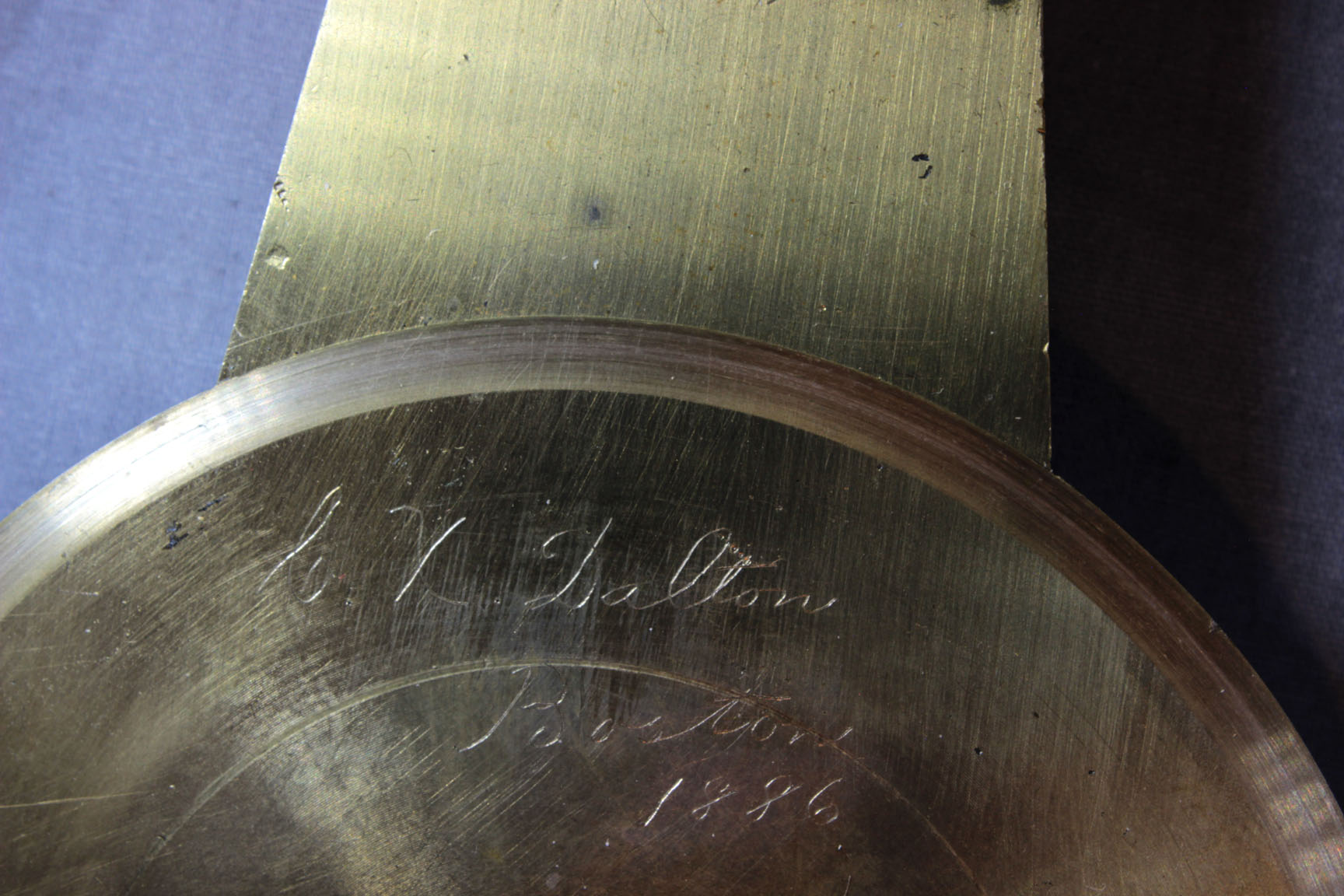 This microscope is a rare binocular microscope constructed by Charles X. Dalton. The microscope stands about 20-21 inches tall as pictured and weighs about 21 lb. It is very likely a late Boston Optical Works (BOW) Model 'A' constructed after the head optician, Robert Tolles died(1883), and Dalton was in charge of the firm, though he had been Tolles' brassworker and foreman since joining Tolles. The stand is unusual in that although outwardly it appears unsigned, it has a hidden scratched signature under the rotating disc that supports the pillars. This was discovered only when a prior owner decided he wanted to disassemble the instrument!
This microscope is a rare binocular microscope constructed by Charles X. Dalton. The microscope stands about 20-21 inches tall as pictured and weighs about 21 lb. It is very likely a late Boston Optical Works (BOW) Model 'A' constructed after the head optician, Robert Tolles died(1883), and Dalton was in charge of the firm, though he had been Tolles' brassworker and foreman since joining Tolles. The stand is unusual in that although outwardly it appears unsigned, it has a hidden scratched signature under the rotating disc that supports the pillars. This was discovered only when a prior owner decided he wanted to disassemble the instrument!
The coarse focus is by straight rack and pinion, while fine is via a nosepiece short lever screw, a method quite out of date by the time this microscope was made, but of such high quality it functions exceptionally well-something the Boston Optical Works (and Dalton himself) was famous for. The interocular distance of the binocular tubes is varied by rack and pinion.
The tapering twin pillars support the trunnion inclination joint and the tension is adjustable. The microscope can rotate on the flat tripod foot which has a tightening knob. The overall form of the stage is the Tolles thin stage, and it is equipped with the Tolles No 2 New Mechanical Stage
first produced in 1882.
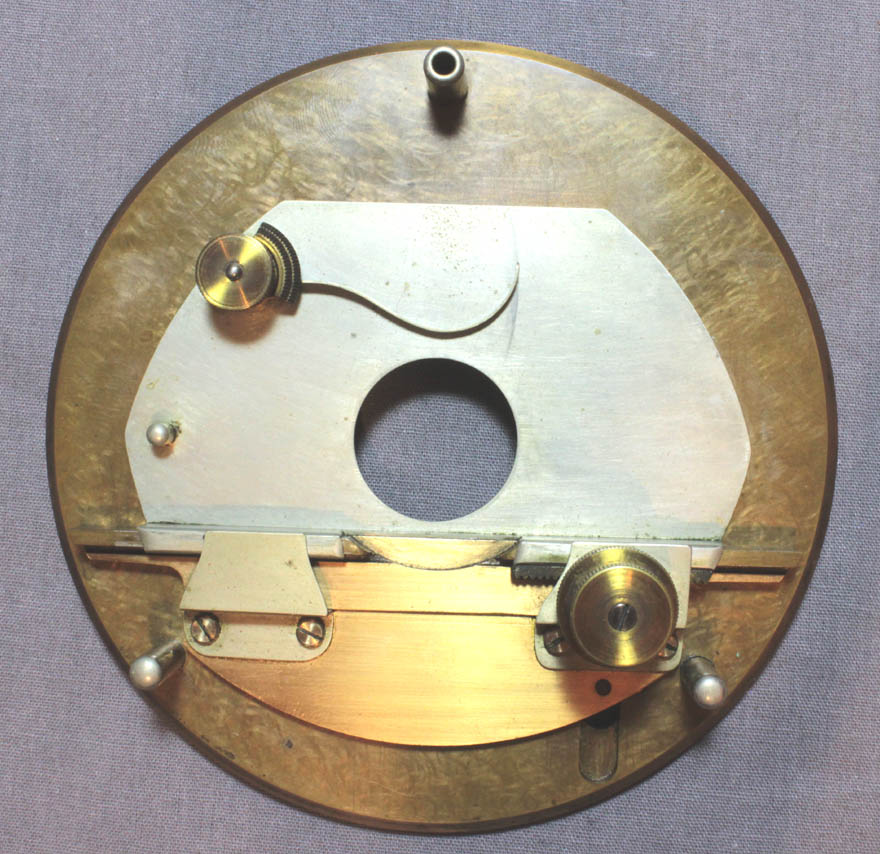 The stage has concentric controls, reminescent of Bulloch's, which was, coincidentally, first made by Bulloch in the early 1880's and reported in the JRMS of 1882.It is notable that Bulloch attributed this type of stage to Charles Spencer while Tolles was Spencer's employee. The mechanical stage is 4.25 inches in diameter. This circular stage can be manually rotated a full 360 degrees.
The stage has concentric controls, reminescent of Bulloch's, which was, coincidentally, first made by Bulloch in the early 1880's and reported in the JRMS of 1882.It is notable that Bulloch attributed this type of stage to Charles Spencer while Tolles was Spencer's employee. The mechanical stage is 4.25 inches in diameter. This circular stage can be manually rotated a full 360 degrees.
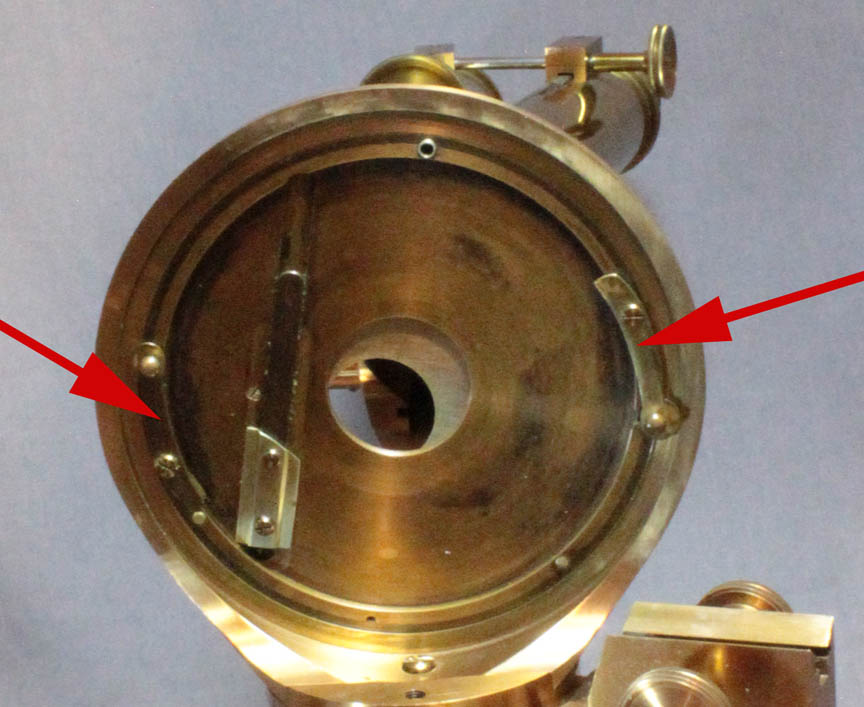 The mechanical stage can be quickly and easily attached or removed from the support ring by a pair of levers(red arrows) on its bottom.
The mechanical stage can be quickly and easily attached or removed from the support ring by a pair of levers(red arrows) on its bottom.
There is a swinging substage with separate axes for the mirror and for the condenser assembly. There are lines to line up the substage mirror tailpieces at the vertical position, and a knob to lock the axes in that position. Interestingly, there are no graduations of the rotating axis for the swinging substage, for rotation of the mechanical stage, for positioning of the slide, nor for the rotation of the foot. This may suggest this microscope was a prototype or a special order item. Although the idea of a swinging substage was not original with Zentmayer, the idea of a swinging substage, with its axis of rotation at the level of the specimen originated with Zentmayer. The idea of a double swinging substage with separate swinging arms for the condenser and the mirror was introduced by Walter Bulloch who introduced the double version. This double system also allows the mirror alone to be used above the stage to illuminate opaque specimens. Bulloch, Tolles and Dalton were all well-acquainted as Bulloch had previously worked for a time at the BOW.
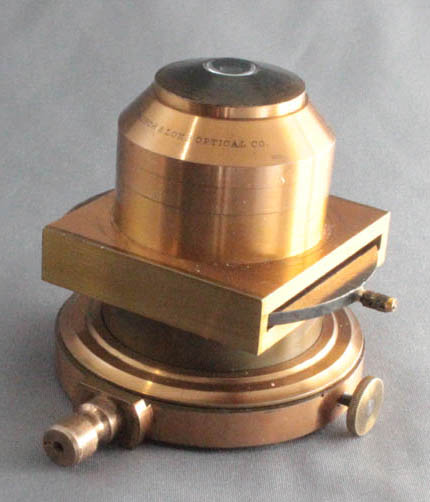 The condenser on this microscope is signed
The condenser on this microscope is signed BAUSCH & LOMB OPTICAL CO.
. The condenser asssembly is centerable via two knurled knobs, 90 degrees apart from each other. The Abbe type condenser is mounted on B & L's square sub-condenser ...Mounting with Five Stops and diaphragms and blue glass.
The rectangular opening of the condenser mount accepts a blackened brass slide which accepts filters, dark field spots or aperture-adjusting inserts singly or in combination. The ring holding the condenser assembly is attached to a stem that is held in place on the focusing substage by a knurled knob and presumably could have been replaced by other accessory apparatus. This type of arrangement, which can be removed by loosening its set screw knob, was typical of Tolles/BOW stands.
OBJECTIVES:
There are seven objectives with this microscope. They include five by Tolles, one by Powell & Lealand and one by the contempory Herbert Spencer. The cans for these objectives are either unmarked (the 1 inch), or are simply marked with the focal lengths in inches (1/2, 1/5, and so on). Four of the Tolles objectives (1 inch, 1/2, 4/10, and 1/8 roughly match the 1872 & 1883 Tolles/BOW catalog descriptions, while the 1/4 matches an entry in the 1883 catalog description of a special 1/4 by Tolles made with long working distance. The other objectives are not long working distance objectives.
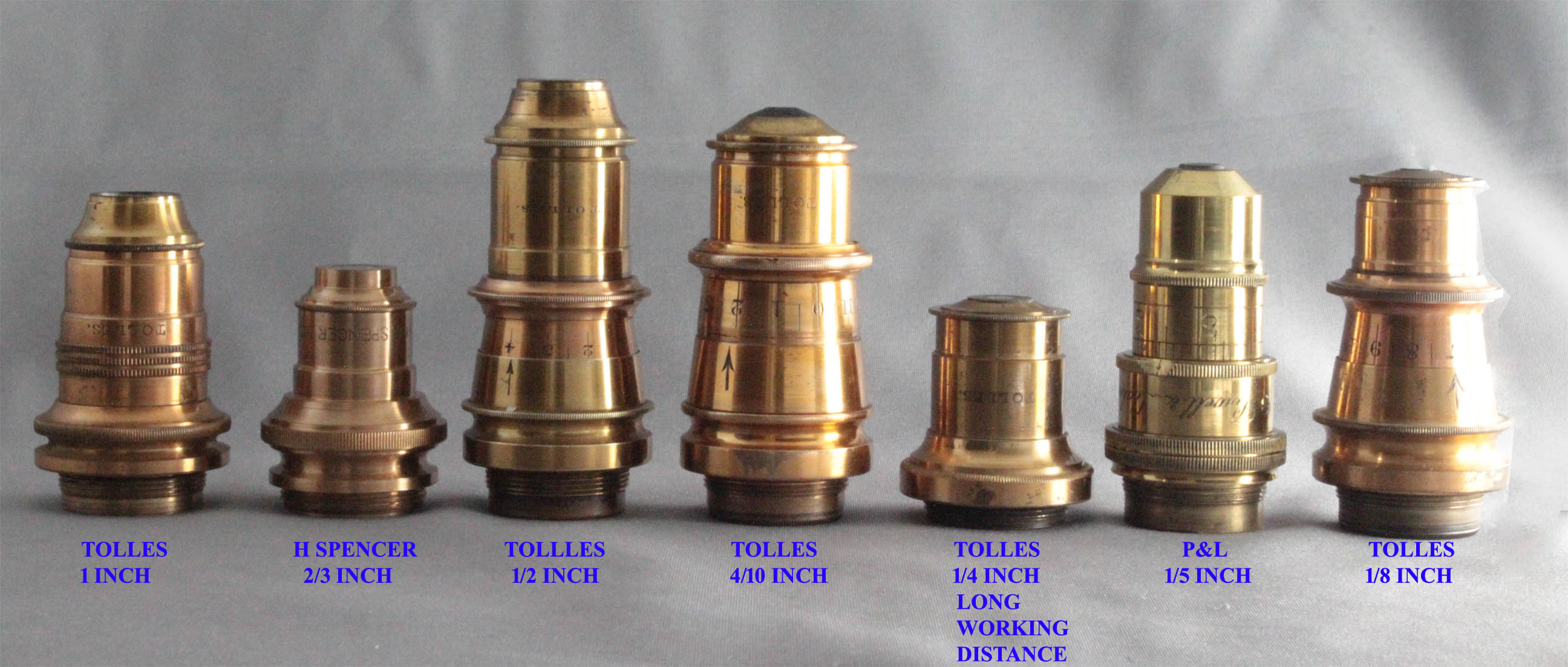
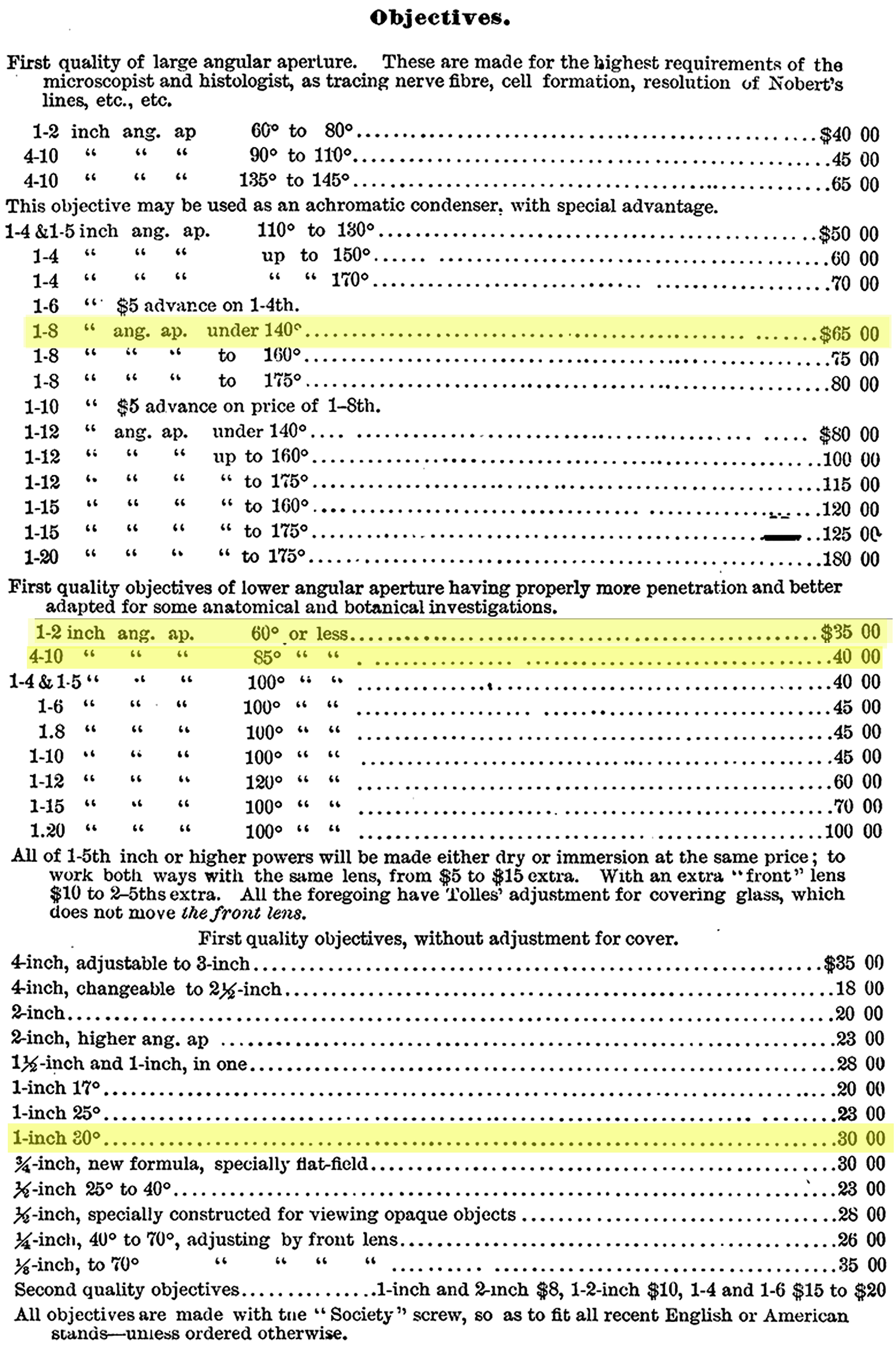
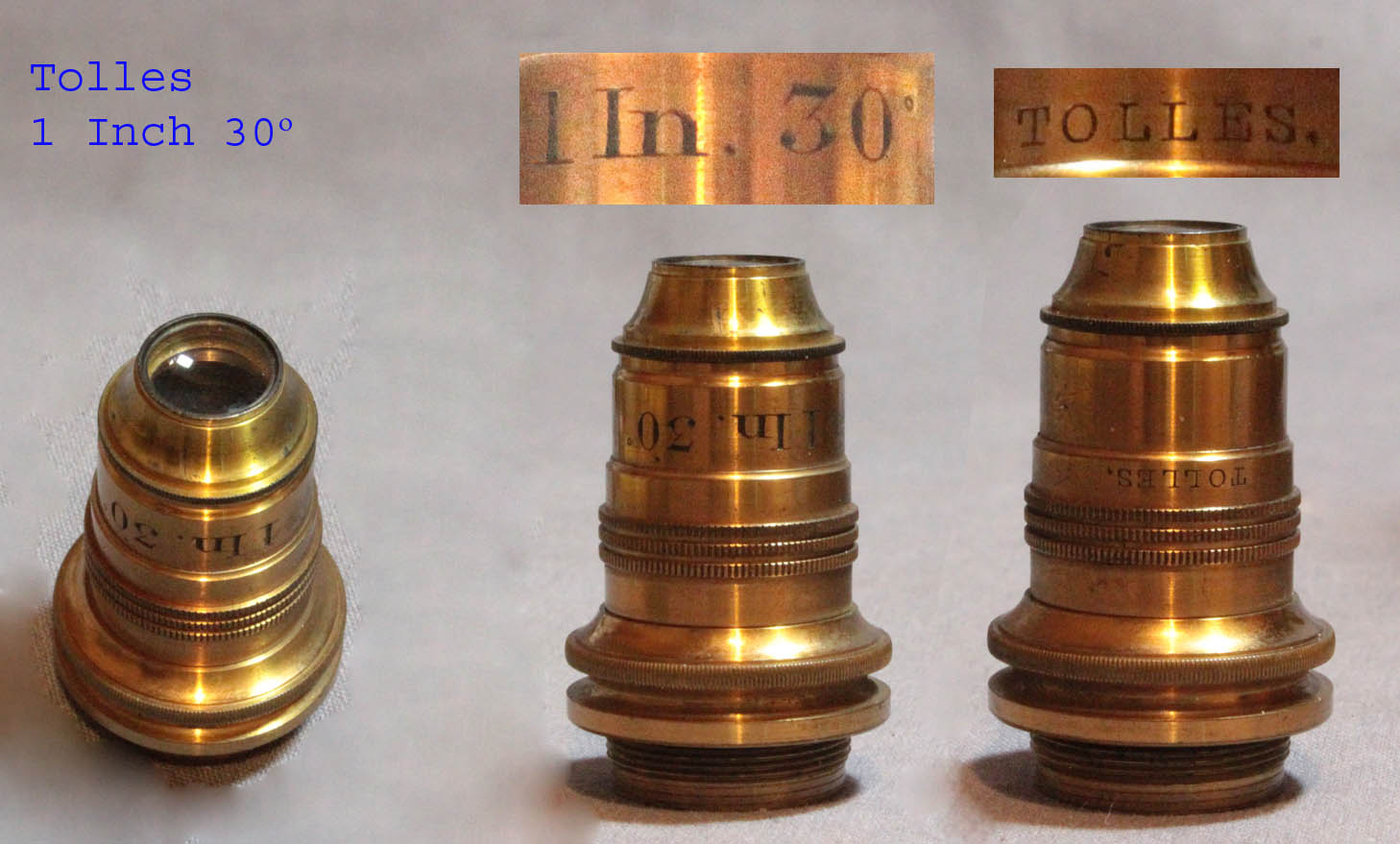
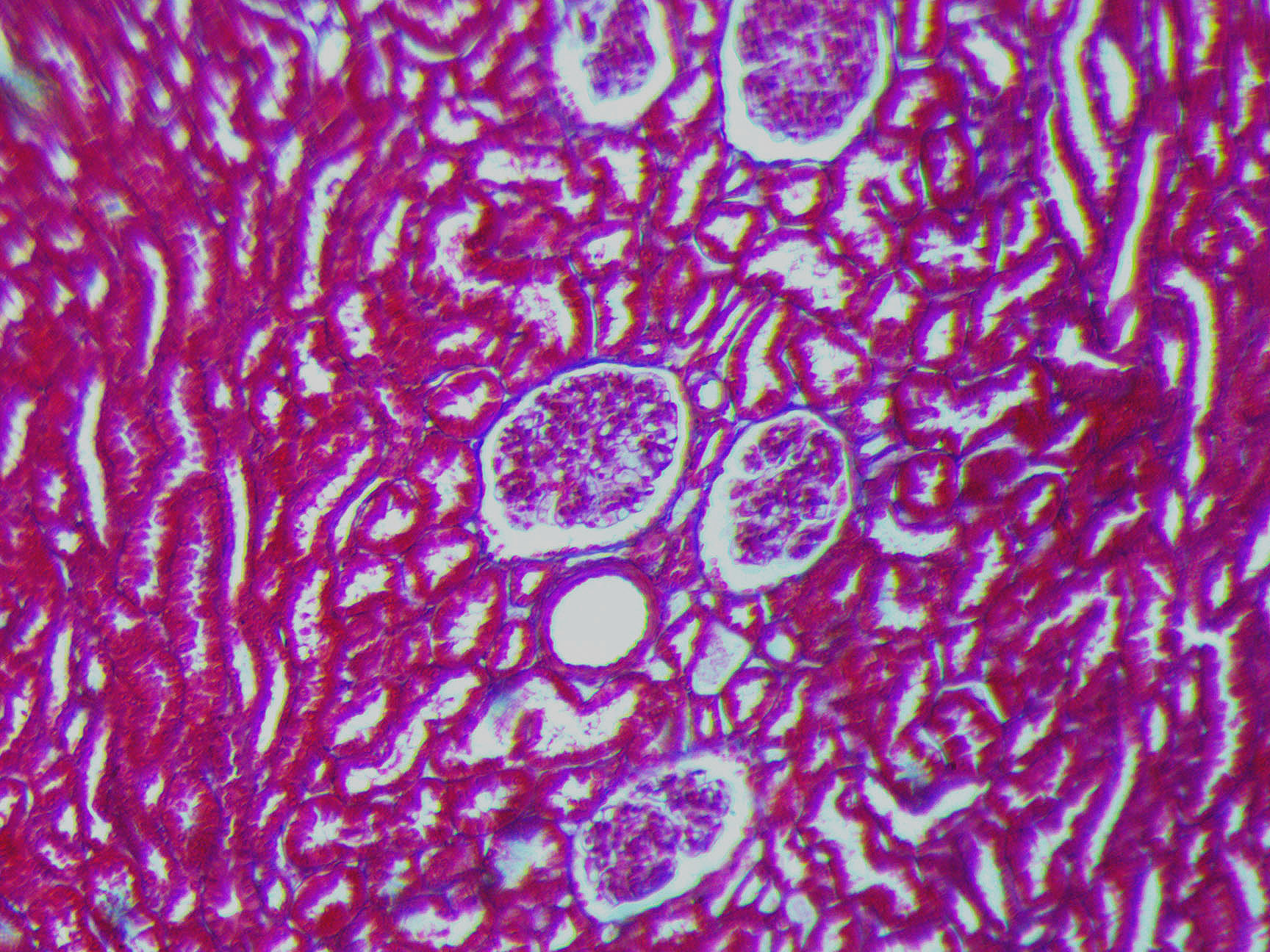
This Tolles 1 inch objective, is engraved with an angular aperture of 30 degrees. This corresponds to an n.a. of 0.26 which is very high for such an objective, even today. This was the highest n.a. 1 inch that Tolles made; today, only the best apochromatic objectives of this magnification have n.a.'s in that range-an amazing achievment for Tolles. On testing this objective with an Abbe apertometer, on the Dalton microscope the n.a. of the objective measured 0.23 n.a. which corresponds very closely to what it is labeled. This is a superb lens with very little aberration and an almost completely flat field (click image for higher resolution view).
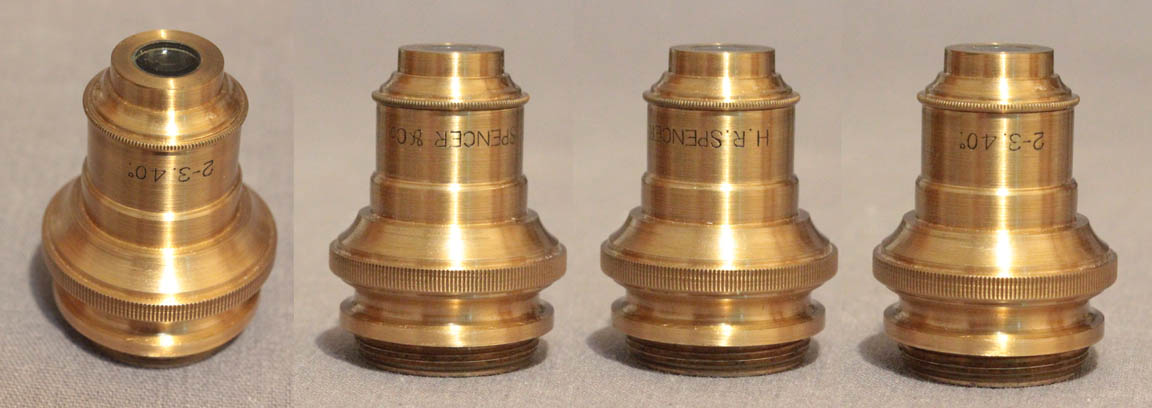
This contemporary 2/3 inch H.R. Spencer & Company objective gives clear distinct images. Its signature of H.R. Spencer & Co. 2-3 40o
dates it to between 1880 and 1889. An angular aperture of 40o corresponds to an n.a. of 0.34. I measured its n.a. at 0.3 which is very good at this magnification and corresponds to an angular aperture of about 35 degrees.
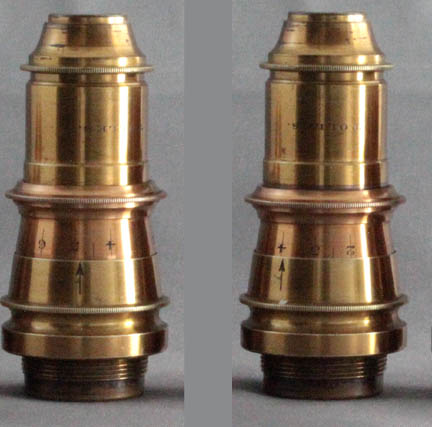
The third objective with this microscope is a fine Tolles 1/2 inch with correction collar in original can. It is about a 20X objective. The measured n.a. of about 0.45 corresponds to an angular aperture of about 29o.
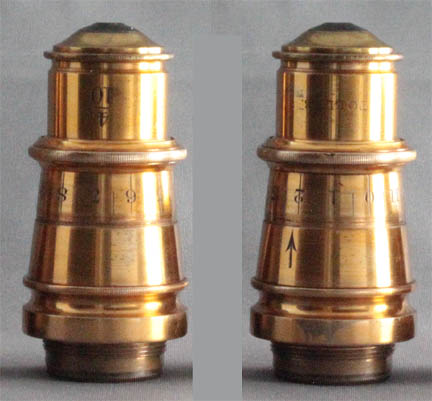
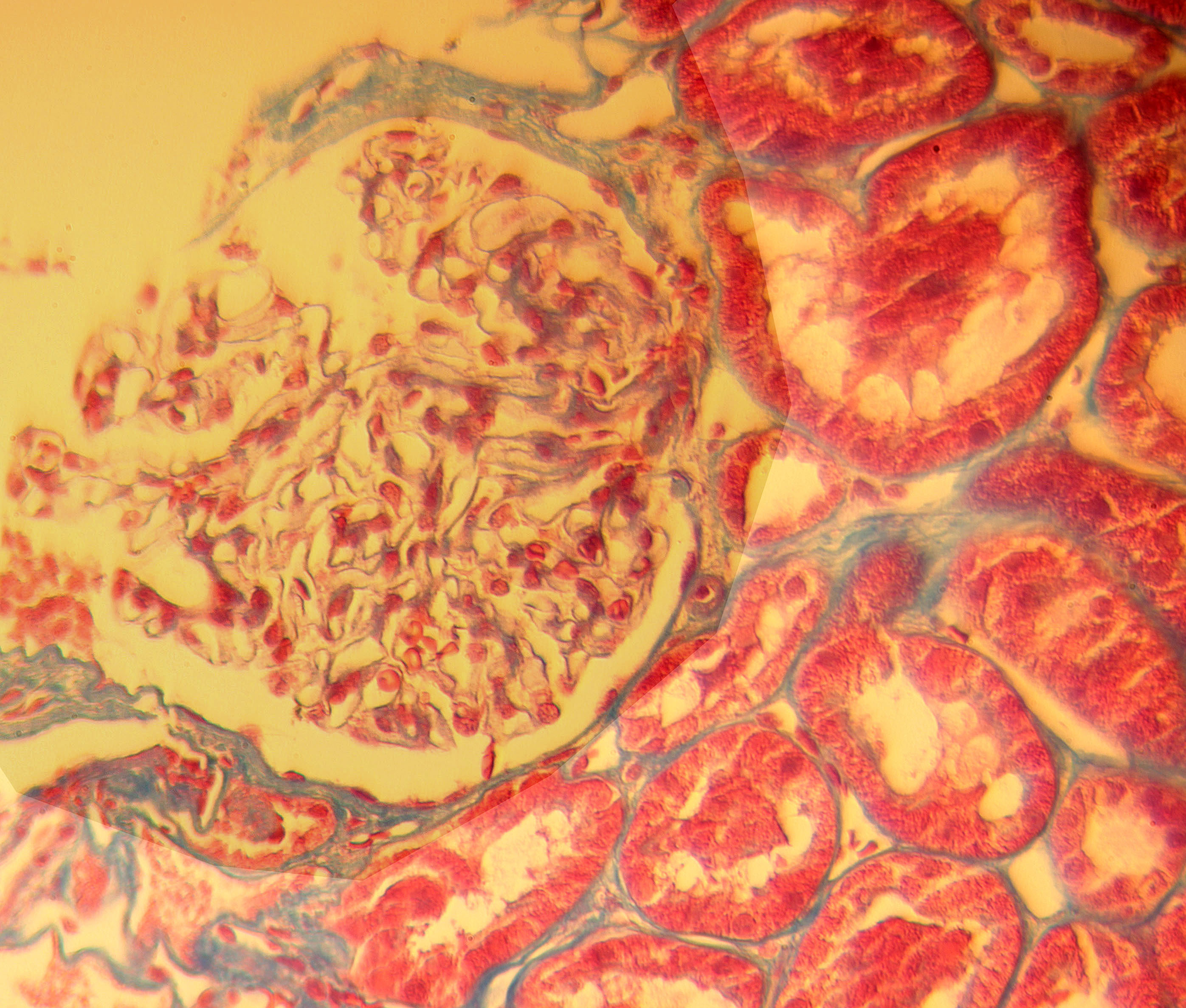
The fourth objective with this microscope is a fine Tolles 4/10 inch with correction collar in original can. This is about a 25X objective. The measured n.a. of this objective measured about 0.55. This corresponds to 66o angular aperture which is excellent for this focal length.
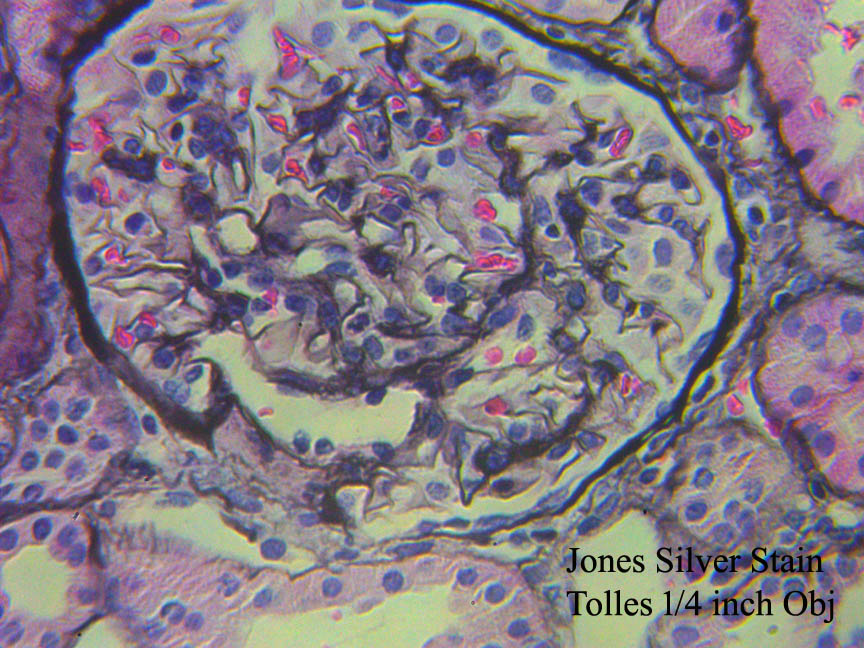
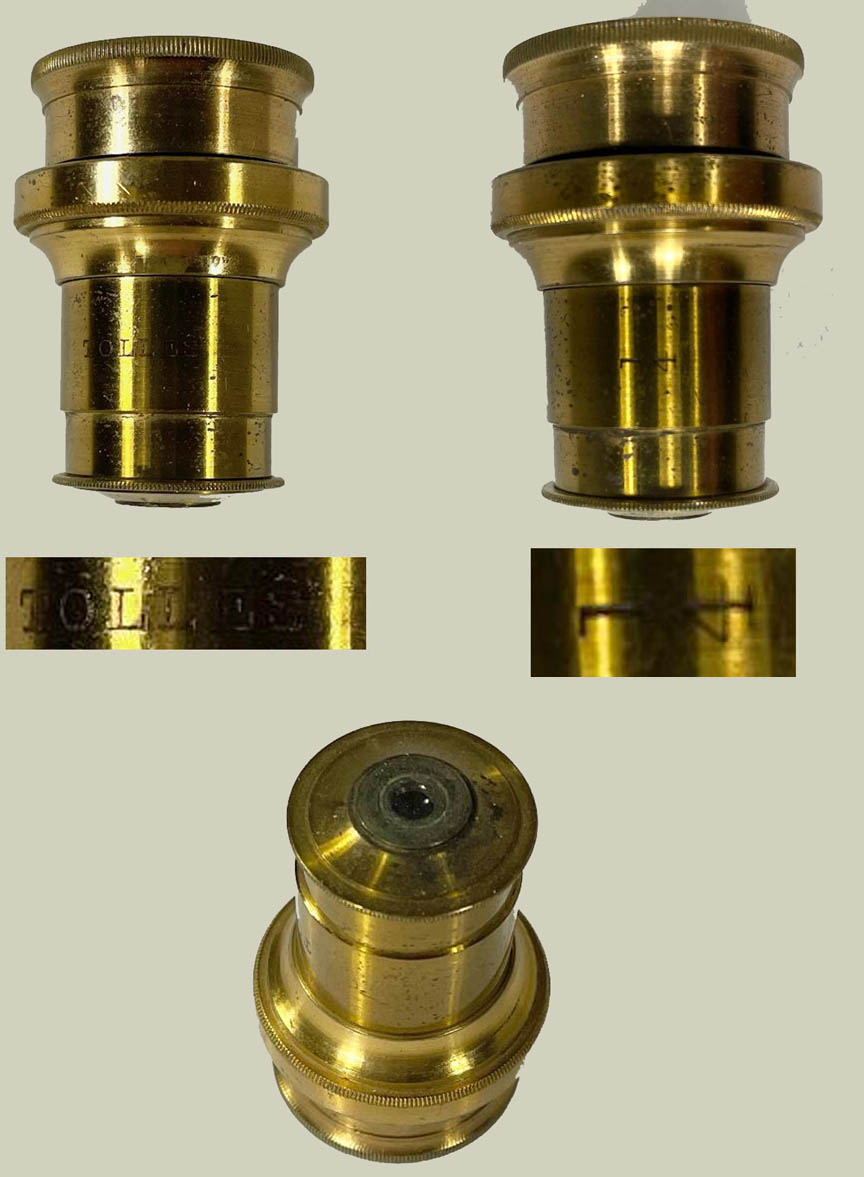
The fifth objective with this microscope is a Tolles 1/4 inch student objective with a measured n.a. of about 0.30, or an angular aperture of about 35 degrees; this is not a high value for a 1/4 inch objective which is a medium power objective of about 40X. The working distance is much higher than 1/4 inch. This lens does not have the resolution of a high n.a. objective, but gives very acceptable images as seen to the right. This is likely the Tolles 2nd quality 1/4 inch objective with long working distance for opaque objects
listed in the BOW catalog. This long working distance lens is an uncommon type of Tolles objective.
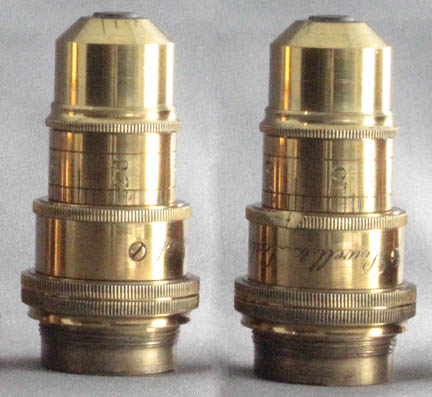
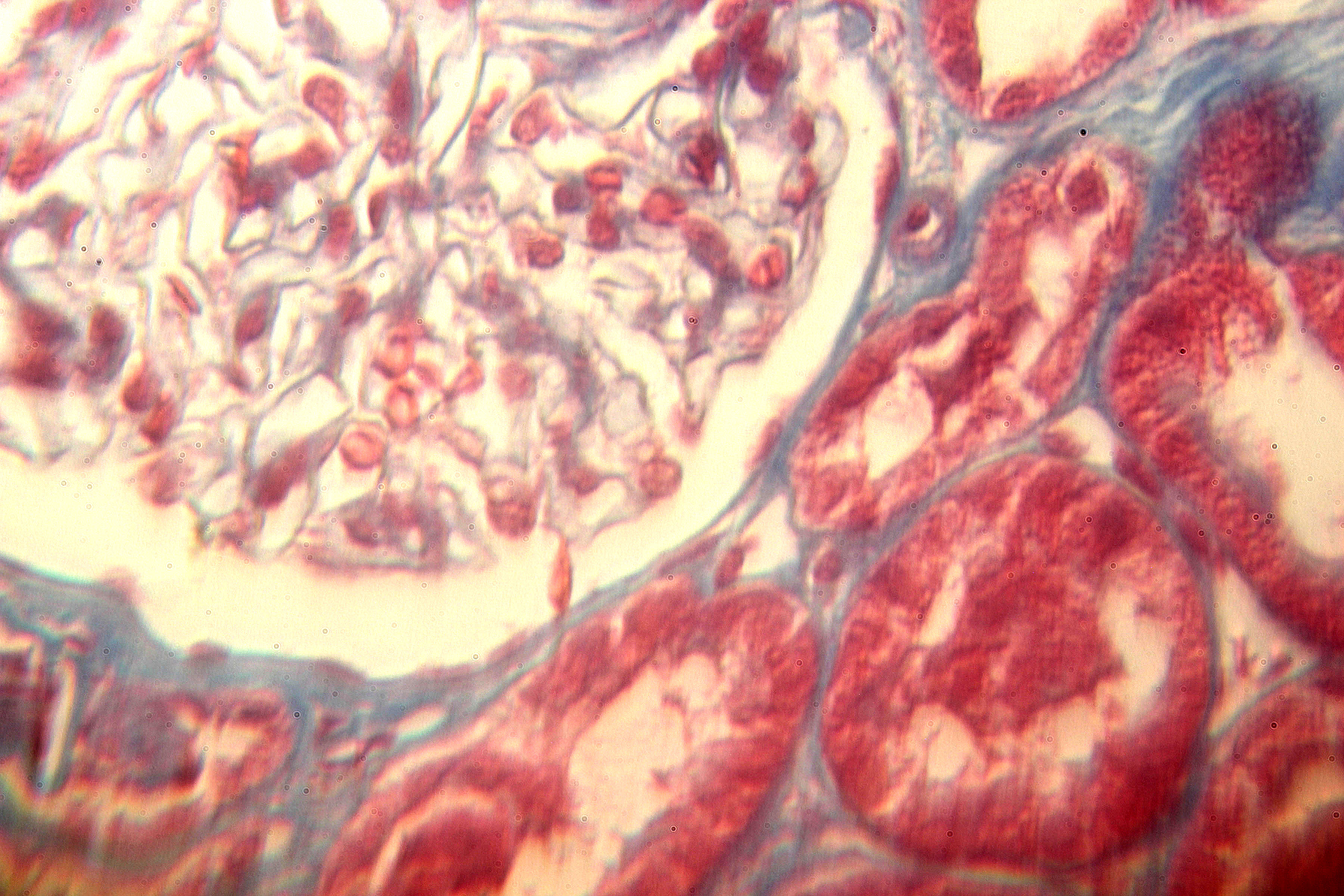 The sixth objective with this microscope is a Powell & Lealand 1/5 inch with correction collar in original can. The n.a. of this objective is about 0.75, which corresponds to 90o of angular aperture. This is very close to the listing for a 1/5th inch objective in the 1875 Powell & Lealand Price List and is a very good n.a. for this focal length.
The sixth objective with this microscope is a Powell & Lealand 1/5 inch with correction collar in original can. The n.a. of this objective is about 0.75, which corresponds to 90o of angular aperture. This is very close to the listing for a 1/5th inch objective in the 1875 Powell & Lealand Price List and is a very good n.a. for this focal length.
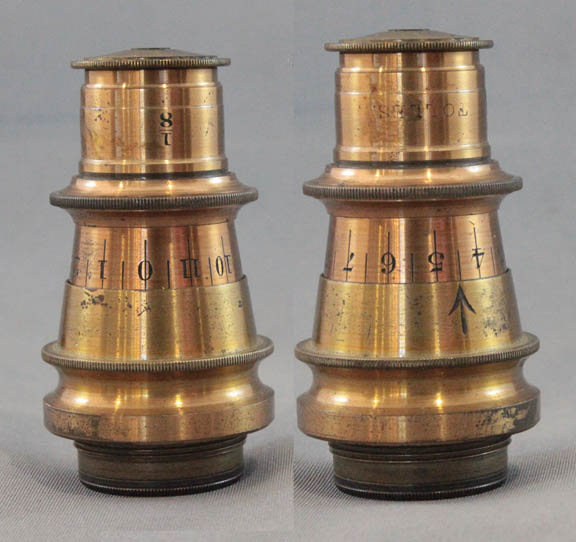
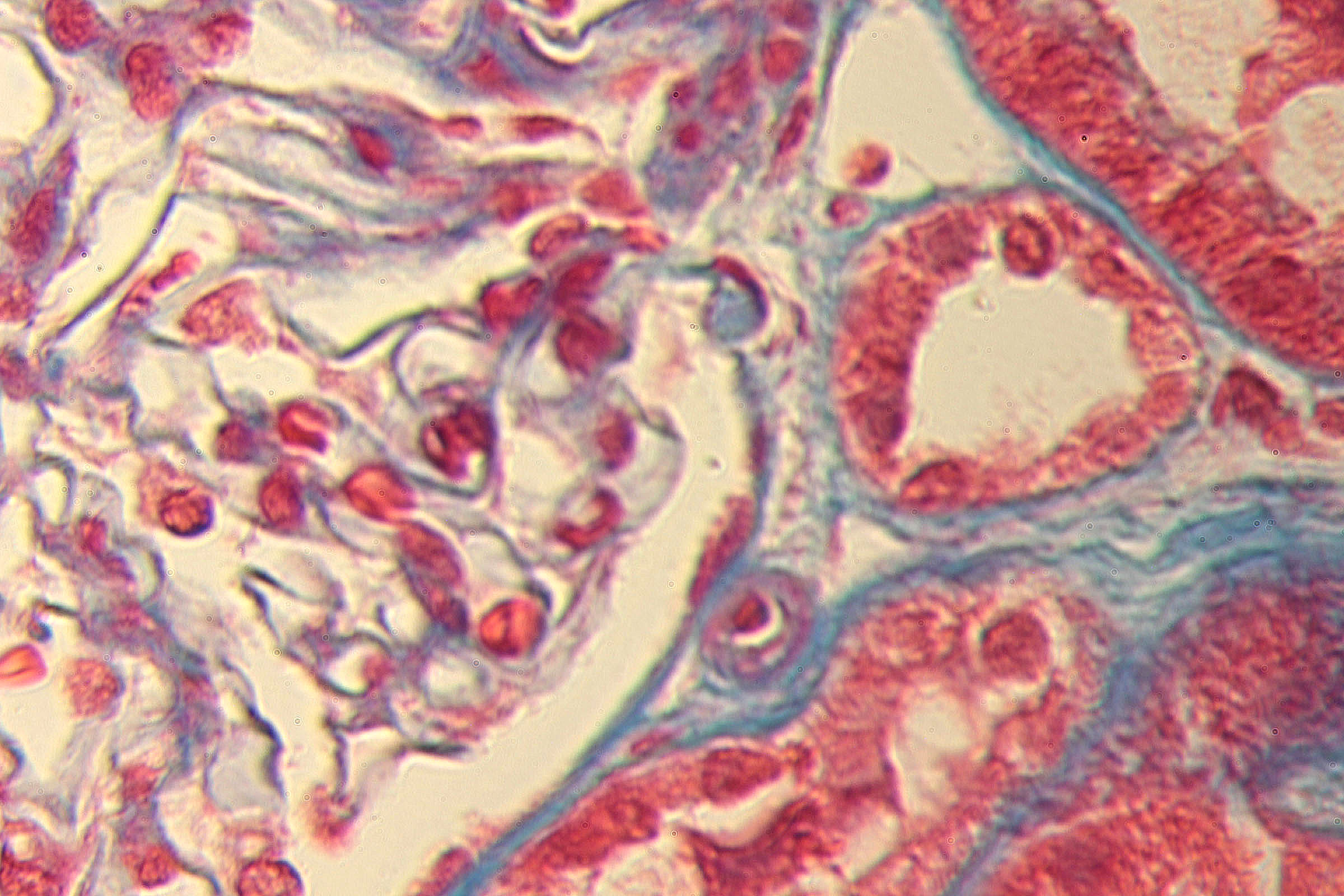 The seventh and highest power objective with this microscope is a Tolles 1/8 inch with correction collar in original can. This would correspond to about a 65X power high dry objective. I measured its n.a. at 0.87, which is 122o of angular aperture. This is equivalent to a modern semi-apochromatic objective.
The seventh and highest power objective with this microscope is a Tolles 1/8 inch with correction collar in original can. This would correspond to about a 65X power high dry objective. I measured its n.a. at 0.87, which is 122o of angular aperture. This is equivalent to a modern semi-apochromatic objective.
HISTORY: The Boston Optical Works(BOW) was founded in Boston with the famous and innovative Robert B. Tolles as Superintendent
. Tolles had previously worked for Charles Spencer, and after that on his own in Canastota, New York until he moved to Boston to head up the BOW. Notably, Charles X. Dalton, who had also previously worked for Spencer also came with Tolles to Boston. Tolles died on November 17, 1883 and Dalton took over the business and continued to advertise Tolles microscopes until at least 1892. For more about the history of Tolles, please the the Introduction on the Tolles & Dalton Review page. For more about the microscopes of both Tolles and Dalton, please see the Review of Microscopes by Tolles and Dalton.
Tolles was known as both an innovator and perfectionist and his lenses and microscopes were among the finest made anywhere. Some features that were notoriously poor when made by others such as the nosepiece short lever fine focus, were made to a much higher standard by Tolles' company. Tolles' brassworks foreman was Charles X. Dalton until Dalton took over running the company on Tolles death. Dalton carried on the unmistakable BOW style and advertised as making Tolles' Microscopes.
The limb of both 'Tolles' original microscopes and the instrument pictured at the top of this page have a similar unique profile and shape.
The BOW made a large 'B' Stand, which weighed about 14 lbs, and had a five inch diameter rotating stage and had a Y-shaped foot. The largest BOW microscope was the 'A' stand which, according to Tolles' catalog, weighed about 20 lbs, had a 6 inch diameter rotating stage, a substage rotating about the axis of the stage to provide oblique illumination, and had the entire stand able to rotate on the flat tripod foot. This description fits the microscope shown on this page, with the exception that the stage diameter is slightly smaller. Further evidence that this is indeed an 'A' stand is provided by the fact that this microscope is identical to the wooden prototype for the A stand, donated to Harvard Medical School by Charles X. Dalton himself, and dated 1876 and it is there documented that the model is a BOW-Tolles 'A' Stand.
This site contains a page including a description of the range of the BOW stands. In the price lists in Frey, H, The Microscope and Microscopical Technology, from both 1872 and 1880, it is noted that that the A stand had graduations on the rotating plate, which this example does not. This is likely because this example was either a display model or not yet fully completed. We also note the absence of graduations on the rotating rings of the tailpieces, the only mark on these being a single line for indicating alignment of the tailpieces with the optical axis of the optical tube. Likewise, the rotation of the stage is ungraduated. It cannot be a prototype, as the date of construction excludes that possibility.
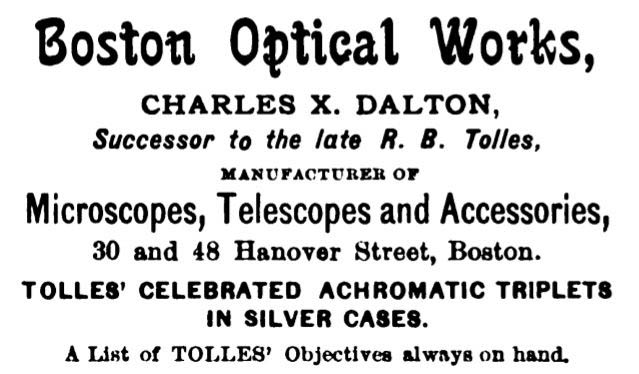 Charles X Dalton was born in Philadelphia and initially worked with Zentmayer before working for Spencer & Eaton. When Tolles left Spencer and went out to work on his own in in Canastota, Dalton went with him and from there to Boston. It is well known that Dalton was the principal brassworker for Tolles and likely constructed many, if not most, of his large microscopes, while Tolles concentrated on the innovations of the microscopes and making the optical parts. Dalton not only carried on the BOW business, but repaired instruments all over the greater Boston area especially at the universities. Because of this, he became well known, and had a reputation of being a very highly skilled machinist as well as a very kind and generous man. He donated several antique instruments to the Harvard University Medical School, and also to the Billings Collection in Washington DC. Dalton not only sold BOW stands, but also those by Zentmayer, Fuess, Bausch & Lomb, and Leitz, and likely others.
Charles X Dalton was born in Philadelphia and initially worked with Zentmayer before working for Spencer & Eaton. When Tolles left Spencer and went out to work on his own in in Canastota, Dalton went with him and from there to Boston. It is well known that Dalton was the principal brassworker for Tolles and likely constructed many, if not most, of his large microscopes, while Tolles concentrated on the innovations of the microscopes and making the optical parts. Dalton not only carried on the BOW business, but repaired instruments all over the greater Boston area especially at the universities. Because of this, he became well known, and had a reputation of being a very highly skilled machinist as well as a very kind and generous man. He donated several antique instruments to the Harvard University Medical School, and also to the Billings Collection in Washington DC. Dalton not only sold BOW stands, but also those by Zentmayer, Fuess, Bausch & Lomb, and Leitz, and likely others.
 In comparing the Dalton-BOW
In comparing the Dalton-BOW A
Microscope to other large stands of the time, it would seem reasonable to compare it to Bulloch's largest stand, the Congress model for two reasons. First Bulloch's influence in the construction of the BOW stand is readily apparent, and secondly they are both the largest stand of their respective makers. In comparing them, they are both very large. The Congress sits on taller pillars; height from the table to the center of inclination of the Bulloch is 7 1/2 inches while on the Dalton it is 6 1/2. The spread of the flat tripod is actually wider for the Dalton being about 11 3/8 inches while the Bulloch is about 10 1/4. The outer diameter of the ring supporting the mechanical stage for the Dalton is 5 inches while for the Bulloch it is 5 1/2, but note that the rotating part of the Dalton stage is of smaller diameter than the ring(4 1/2 inches), while for the Bulloch, the rotating portion is the same size as the ring or slightly larger, overlapping the top of the ring. Note that both have stages that are quite thin, to allow extreme oblique illumination. When one compares the feet, the mechanical stages, and the dual swinging substages, Bulloch's influence seems clear. This is not surprising, since Bulloch worked for the BOW from 1871 to 1872, when Tolles was still superintendent. Dalton was the principal brass worker when Bulloch joined the company, and undoubtedly his work and ideas continued to be well known to Tolles and Dalton after Bulloch returned to Chicago.
The author is grateful to his co-editors, Dr Joseph Zeligs and Dr Jurriaan de Groot, as well as James Solliday for their editorial help and suggestions with the pages about Dalton and Tolles microscopes and accessories.
 This microscope is a rare binocular microscope constructed by Charles X. Dalton. The microscope stands about 20-21 inches tall as pictured and weighs about 21 lb. It is very likely a late Boston Optical Works (BOW) Model 'A' constructed after the head optician, Robert Tolles died(1883), and Dalton was in charge of the firm, though he had been Tolles' brassworker and foreman since joining Tolles. The stand is unusual in that although outwardly it appears unsigned, it has a hidden scratched signature under the rotating disc that supports the pillars. This was discovered only when a prior owner decided he wanted to disassemble the instrument!
This microscope is a rare binocular microscope constructed by Charles X. Dalton. The microscope stands about 20-21 inches tall as pictured and weighs about 21 lb. It is very likely a late Boston Optical Works (BOW) Model 'A' constructed after the head optician, Robert Tolles died(1883), and Dalton was in charge of the firm, though he had been Tolles' brassworker and foreman since joining Tolles. The stand is unusual in that although outwardly it appears unsigned, it has a hidden scratched signature under the rotating disc that supports the pillars. This was discovered only when a prior owner decided he wanted to disassemble the instrument!  The stage has concentric controls, reminescent of Bulloch's, which was, coincidentally, first made by Bulloch in the early 1880's and reported in the JRMS of 1882.It is notable that Bulloch attributed this type of stage to Charles Spencer while Tolles was Spencer's employee. The mechanical stage is 4.25 inches in diameter. This circular stage can be manually rotated a full 360 degrees.
The stage has concentric controls, reminescent of Bulloch's, which was, coincidentally, first made by Bulloch in the early 1880's and reported in the JRMS of 1882.It is notable that Bulloch attributed this type of stage to Charles Spencer while Tolles was Spencer's employee. The mechanical stage is 4.25 inches in diameter. This circular stage can be manually rotated a full 360 degrees.  The mechanical stage can be quickly and easily attached or removed from the support ring by a pair of levers(red arrows) on its bottom.
The mechanical stage can be quickly and easily attached or removed from the support ring by a pair of levers(red arrows) on its bottom.  The condenser on this microscope is signed
The condenser on this microscope is signed 










 The sixth objective with this microscope is a Powell & Lealand 1/5 inch with correction collar in original can. The n.a. of this objective is about 0.75, which corresponds to 90o of angular aperture. This is very close to the listing for a 1/5th inch objective in the 1875 Powell & Lealand Price List and is a very good n.a. for this focal length.
The sixth objective with this microscope is a Powell & Lealand 1/5 inch with correction collar in original can. The n.a. of this objective is about 0.75, which corresponds to 90o of angular aperture. This is very close to the listing for a 1/5th inch objective in the 1875 Powell & Lealand Price List and is a very good n.a. for this focal length.
 The seventh and highest power objective with this microscope is a Tolles 1/8 inch with correction collar in original can. This would correspond to about a 65X power high dry objective. I measured its n.a. at 0.87, which is 122o of angular aperture. This is equivalent to a modern semi-apochromatic objective.
The seventh and highest power objective with this microscope is a Tolles 1/8 inch with correction collar in original can. This would correspond to about a 65X power high dry objective. I measured its n.a. at 0.87, which is 122o of angular aperture. This is equivalent to a modern semi-apochromatic objective.
 Charles X Dalton was born in Philadelphia and initially worked with Zentmayer before working for Spencer & Eaton. When Tolles left Spencer and went out to work on his own in in Canastota, Dalton went with him and from there to Boston. It is well known that Dalton was the principal brassworker for Tolles and likely constructed many, if not most, of his large microscopes, while Tolles concentrated on the innovations of the microscopes and making the optical parts. Dalton not only carried on the BOW business, but repaired instruments all over the greater Boston area especially at the universities. Because of this, he became well known, and had a reputation of being a very highly skilled machinist as well as a very kind and generous man. He donated several antique instruments to the Harvard University Medical School, and also to the Billings Collection in Washington DC. Dalton not only sold BOW stands, but also those by Zentmayer, Fuess, Bausch & Lomb, and Leitz, and likely others.
Charles X Dalton was born in Philadelphia and initially worked with Zentmayer before working for Spencer & Eaton. When Tolles left Spencer and went out to work on his own in in Canastota, Dalton went with him and from there to Boston. It is well known that Dalton was the principal brassworker for Tolles and likely constructed many, if not most, of his large microscopes, while Tolles concentrated on the innovations of the microscopes and making the optical parts. Dalton not only carried on the BOW business, but repaired instruments all over the greater Boston area especially at the universities. Because of this, he became well known, and had a reputation of being a very highly skilled machinist as well as a very kind and generous man. He donated several antique instruments to the Harvard University Medical School, and also to the Billings Collection in Washington DC. Dalton not only sold BOW stands, but also those by Zentmayer, Fuess, Bausch & Lomb, and Leitz, and likely others.  In comparing the Dalton-BOW
In comparing the Dalton-BOW